Gelöste Aufgaben/JUMP/Car-Body: Unterschied zwischen den Versionen
| Zeile 11: | Zeile 11: | ||
We’ll need to invest significant efforts in describing the kinematics of the car-motion and to derive its equations of body-motion since we do not want to limit our study on small pitch-angles of the car. Key accessory will be [[Sources/Lexikon/Vektor|vectors]], which map locations like the center of mass: | We’ll need to invest significant efforts in describing the kinematics of the car-motion and to derive its equations of body-motion since we do not want to limit our study on small pitch-angles of the car. Key accessory will be [[Sources/Lexikon/Vektor|vectors]], which map locations like the center of mass: | ||
<math>\vec{r}_C(t)</math>. | ::<math>\vec{r}_C(t)</math>. | ||
This vector has - in 2D - two coordinates <math>u_1(t), u_2(t)</math>, measured in the inertial ''x-y'' frame: | This vector has - in 2D - two coordinates <math>u_1(t), u_2(t)</math>, measured in the inertial ''x-y'' frame: | ||
<math>\vec{r}_C(t) = \vec{\underline{e}}_0 \cdot \left(\begin{array}{c} u_1\\u_2\end{array}\right)</math> with <math>\vec{\underline{e}}_0 = \left(\vec{e}_x, \vec{e}_y \right)</math>. | ::<math>\vec{r}_C(t) = \vec{\underline{e}}_0 \cdot \left(\begin{array}{c} u_1\\u_2\end{array}\right)</math> with <math>\vec{\underline{e}}_0 = \left(\vec{e}_x, \vec{e}_y \right)</math>. | ||
representing the unit vectors spanning the ''x-y'' space. If we refer to a specific frame, we may drop the vector-notation <math>(\vec{.})</math> and refer to the column-matrix of coordinates <math>(\underline{.})</math> only, so | representing the unit vectors spanning the ''x-y'' space. If we refer to a specific frame, we may drop the vector-notation <math>(\vec{.})</math> and refer to the column-matrix of coordinates <math>(\underline{.})</math> only, so | ||
<math>\underline{r}_C = \left( \begin{array}{c}u_1\\u_2\end{array}\right)</math>. | ::<math>\underline{r}_C = \left( \begin{array}{c}u_1\\u_2\end{array}\right)</math>. | ||
We’ll also employ coordinate transformations using [[Sources/Lexikon/Euler-Rotation|Euler-rotations]]. | We’ll also employ coordinate transformations using [[Sources/Lexikon/Euler-Rotation|Euler-rotations]]. | ||
Version vom 10. März 2021, 10:54 Uhr
Scope
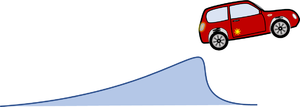
In common simulation applications - especially for full-size commercial cars - the pitch-angle of the car is assumed to be small to allow for a linearization of geometry and most parts of the equations of motion. We drop this limitation so we can do more fancy stuff with our model - like climbing steep roads or jumping across ditches.

We employ a spatial x-y coordinate system, x in horizontal, y in vertical, upwards direction. And we’ll briefly employ the z-axis as rotation direction - which is towards you following the “right-hand-rule“ for coordinate systems.
Structure
The driver controls the car's motion via the position of the "gas"-pedal, which is being translated into a torque MW at the wheel.
This toque will change velocities and thus the position of the car. These state-variables will then create - via info - a feedback to the driver.
We’ll need to invest significant efforts in describing the kinematics of the car-motion and to derive its equations of body-motion since we do not want to limit our study on small pitch-angles of the car. Key accessory will be vectors, which map locations like the center of mass:
- .
This vector has - in 2D - two coordinates , measured in the inertial x-y frame:
- with .
representing the unit vectors spanning the x-y space. If we refer to a specific frame, we may drop the vector-notation and refer to the column-matrix of coordinates only, so
- .
We’ll also employ coordinate transformations using Euler-rotations.
The car with front-wheel drive consists of the car-body with center of mass “C“, the front wheels “A“ and the rear wheel “B“. Masses of car-body and wheel-sets are M and m respectively.The geometry of the car is described by
- a0: the wheel base;
- a1: longitudinal distance between center of mass and front-wheel-hub;
- a2 = a0 - a1 and
- a3: vertical distance between center of mass and front-wheel-hub (relaxed springs).
Model
Variables
Parameter
x
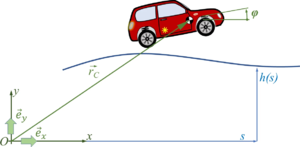
y

z
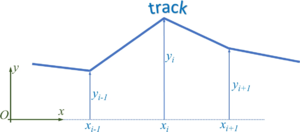
a

b
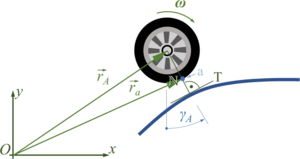
c

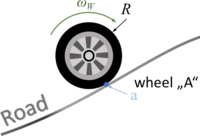
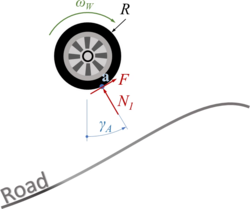
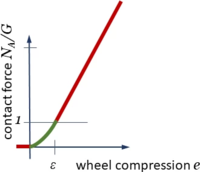
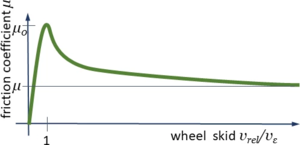
next workpackage: driver-controls →
References
- ...